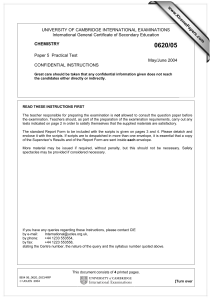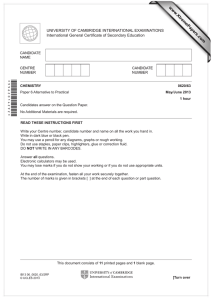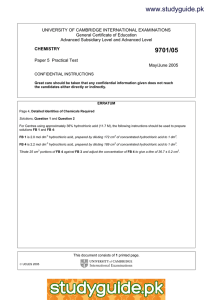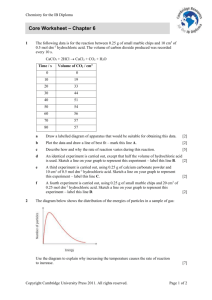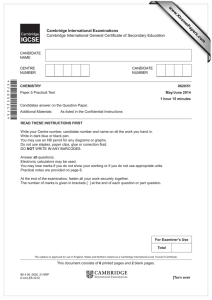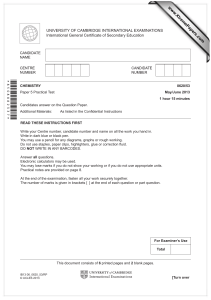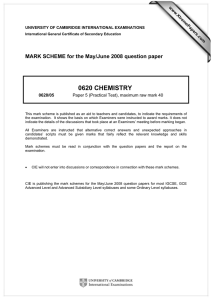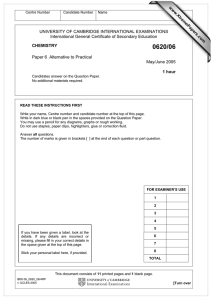www.XtremePapers.com Cambridge International Examinations Cambridge International General Certifi cate of Secondary Education
advertisement
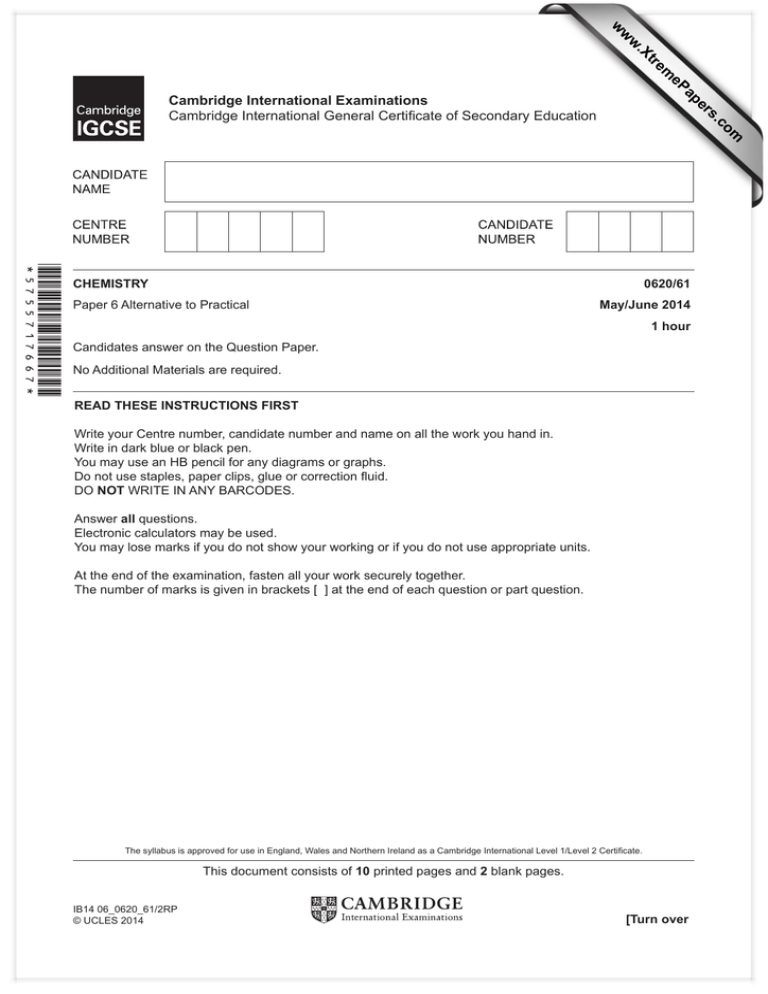
w w ap eP m e tr .X w om .c s er Cambridge International Examinations Cambridge International General Certificate of Secondary Education CHEMISTRY 0620/61 Paper 6 Alternative to Practical May/June 2014 1 hour Candidates answer on the Question Paper. No Additional Materials are required. READ THESE INSTRUCTIONS FIRST Write your Centre number, candidate number and name on all the work you hand in. Write in dark blue or black pen. You may use an HB pencil for any diagrams or graphs. Do not use staples, paper clips, glue or correction fluid. DO NOT WRITE IN ANY BARCODES. Answer all questions. Electronic calculators may be used. You may lose marks if you do not show your working or if you do not use appropriate units. At the end of the examination, fasten all your work securely together. The number of marks is given in brackets [ ] at the end of each question or part question. The syllabus is approved for use in England, Wales and Northern Ireland as a Cambridge International Level 1/Level 2 Certificate. This document consists of 10 printed pages and 2 blank pages. IB14 06_0620_61/2RP © UCLES 2014 [Turn over 2 1 A student separated a mixture of two alcohols, ethanol (boiling point 78 C) and butanol (boiling point 118 C). The apparatus used is shown below. mixture of alcohols heat (a) Complete the boxes to identify the pieces of apparatus labelled. [2] (b) Label the arrows. [1] (c) State the name of this separation process. .............................................................................................................................................. [2] (d) (i) Which liquid is first to collect in the beaker? ....................................................................................................................................... [1] (ii) How would the student know when all of this liquid had collected? ............................................................................................................................................. ....................................................................................................................................... [1] © UCLES 2014 0620/61/M/J/14 3 (e) Identify and explain a possible hazard in this experiment. .................................................................................................................................................... .............................................................................................................................................. [2] [Total: 9] 2 The following paragraph was taken from a student’s notebook. Preparation of lead chloride 10 cm3 of aqueous lead nitrate was placed in a beaker and 10 cm3 of aqueous potassium chloride added. Lead chloride, a white solid, was formed. The solid was separated from the mixture. Water was then added to the solid and the mixture boiled. A clear liquid was formed. On cooling, white crystals were deposited. (a) What type of chemical reaction resulted in the formation of the lead chloride? .............................................................................................................................................. [1] (b) What is the solubility of lead chloride in (i) cold water, .......................................................................................................................... (ii) hot water? ..................................................................................................................... [2] (c) What method should be used to separate the crystals from the mixture? .............................................................................................................................................. [1] [Total: 4] © UCLES 2014 0620/61/M/J/14 [Turn over 4 3 A student investigated the reaction of zinc powder with dilute hydrochloric acid using the apparatus below. gas syringe hydrochloric acid zinc The same mass of zinc was added to different volumes of hydrochloric acid at room temperature, 20 C. The total volume of hydrogen gas given off in each experiment was measured. (a) Use the gas syringe diagrams to record the volumes of hydrogen gas in the table. volume of hydrochloric acid / cm3 0 5 10 15 20 30 40 volume of hydrogen gas / cm3 gas syringe diagram 0 10 20 30 40 50 60 0 10 20 30 40 50 60 0 10 20 30 40 50 60 0 10 20 30 40 50 60 0 10 20 30 40 50 60 0 10 20 30 40 50 60 0 10 20 30 40 50 60 [3] © UCLES 2014 0620/61/M/J/14 5 (b) On the grid, plot the points and draw a smooth line graph. 60 40 volume of hydrogen gas / cm3 20 0 0 10 20 30 40 volume of hydrochloric acid / cm3 [4] (c) (i) Which point is inaccurate? ....................................................................................................................................... [1] (ii) Suggest a possible reason for this inaccurate measurement. ....................................................................................................................................... [1] (iii) Use your graph to work out the volume that would be expected to be formed. Show clearly on the grid how you got your answer. ....................................................................................................................................... [2] (d) Explain why the volume of hydrogen gas does not increase after 30 cm3 of hydrochloric acid. .................................................................................................................................................... .............................................................................................................................................. [2] (e) Sketch on the grid the graph you would expect if the experiments were repeated using the same mass of zinc granules. [2] [Total: 15] © UCLES 2014 0620/61/M/J/14 [Turn over 6 4 A student investigated the reaction between dilute hydrochloric acid and an aqueous alkaline solution R, containing two different substances, S and T. Three experiments were carried out. Experiment 1 Using a measuring cylinder, 25 cm3 of solution R was poured into a conical flask and five drops of phenolphthalein were added to the flask. A burette was filled with hydrochloric acid up to the 0.0 cm3 mark. Hydrochloric acid was added to the solution R and the flask shaken. Addition of hydrochloric acid was continued until the colour just disappeared. The mixture in the flask was kept for Experiment 2. (a) Use the burette diagram to record the final volume in the table of results and complete the table. 16 17 18 final burette reading burette readings final volume / cm3 initial volume / cm3 difference / cm3 [3] Experiment 2 Five drops of methyl orange indicator were added to the mixture in the flask from Experiment 1. The mixture turned yellow. The initial volume reading of the burette was the same as the final reading in Experiment 1. Hydrochloric acid was added from the burette to the mixture in the flask and the mixture shaken. The volume of hydrochloric acid added was recorded when the indicator just changed colour. (b) Use the burette diagram to record the final volume in the table of results and complete the table. 24 25 26 final burette reading burette readings final volume / cm3 initial volume / cm3 difference / cm3 [3] © UCLES 2014 0620/61/M/J/14 7 (c) Experiment 3 Hydrochloric acid was added to about 5 cm3 of solution R in a test-tube. Rapid effervescence was observed. (d) When phenolphthalein indicator was used in Experiment 1 the colour changed from pink to .......................................................................................................................... [1] (e) In a similar experiment, methyl orange indicator was used in Experiment 1 followed by phenolphthalein in Experiment 2. Suggest why this experiment would not work. .................................................................................................................................................... .............................................................................................................................................. [1] (f) What conclusion can you draw from Experiment 3? .............................................................................................................................................. [1] (g) The volume of hydrochloric acid added in Experiment 1 reacted with all of substance S and half of substance T. The volume of hydrochloric acid in Experiment 2 reacted with half of substance T. (i) Work out the volume of hydrochloric acid which reacted with substance S. ....................................................................................................................................... [2] (ii) Work out the volume of hydrochloric acid which reacted with substance T. ....................................................................................................................................... [1] (iii) Compare the volumes of hydrochloric acid which reacted with substances S and T. ....................................................................................................................................... [1] (h) (i) The experiments were repeated using 100 cm3 of solution R. Predict the volume of hydrochloric acid which would be added in Experiments 1 and 2. Explain your answer. Experiment 1 ...................................................................................................................... Experiment 2 ...................................................................................................................... Explanation ................................................................................................................... [3] (ii) Suggest a practical problem that would occur when carrying out these repeat experiments and how you could solve this problem. ............................................................................................................................................. ....................................................................................................................................... [2] [Total: 18] © UCLES 2014 0620/61/M/J/14 [Turn over 8 5 A solid U was analysed. U was a soluble metal sulfate. The tests on U, and some of the observations are in the following table. Complete the observations. tests observations tests on solid U (a) Appearance of solid U. (b) Solid U was heated gently and then strongly in a test-tube. pink crystals condensation droplets formed on the sides of the test-tube (c) Solid U was added to distilled water in a test-tube and shaken until dissolved. The solution was divided into three equal portions in separate test-tubes and the following tests carried out. Several drops of aqueous sodium hydroxide were added to the first portion of the solution and the test-tube shaken. pale brown precipitate Then hydrogen peroxide solution was added to the mixture and the gas given off tested. (d) Dilute nitric acid was added to the second portion of the solution followed by barium nitrate solution. (e) Dilute nitric acid was added to the third portion of the solution followed by silver nitrate solution. © UCLES 2014 effervescence glowing splint relit ............................................................................................ ...................................................................................... [2] ...................................................................................... [1] 0620/61/M/J/14 9 (f) What does test (e) tell you about solid U? .............................................................................................................................................. [1] (g) Name the gas given off in test (c). .............................................................................................................................................. [1] (h) What conclusions can you draw about solid U? .................................................................................................................................................... .............................................................................................................................................. [2] [Total: 7] © UCLES 2014 0620/61/M/J/14 [Turn over 10 6 Nuts contain oil. Nuts can be burned to produce energy. The apparatus shown can be used to compare the energy produced by burning different nuts. thermometer water nut Plan an investigation to show which of three different types of nut produce the most energy. You are provided with peanuts, brazil nuts and hazelnuts. ........................................................................................................................................................... ........................................................................................................................................................... ........................................................................................................................................................... ........................................................................................................................................................... ........................................................................................................................................................... ........................................................................................................................................................... ........................................................................................................................................................... ........................................................................................................................................................... ..................................................................................................................................................... [7] [Total: 7] © UCLES 2014 0620/61/M/J/14 11 BLANK PAGE © UCLES 2014 0620/61/M/J/14 12 BLANK PAGE Permission to reproduce items where third-party owned material protected by copyright is included has been sought and cleared where possible. Every reasonable effort has been made by the publisher (UCLES) to trace copyright holders, but if any items requiring clearance have unwittingly been included the publisher will be pleased to make amends at the earliest possible opportunity. Cambridge International Examinations is part of the Cambridge Assessment Group. Cambridge Assessment is the brand name of University of Cambridge Local Examinations Syndicate (UCLES), which is itself a department of the University of Cambridge. © UCLES 2014 0620/61/M/J/14
